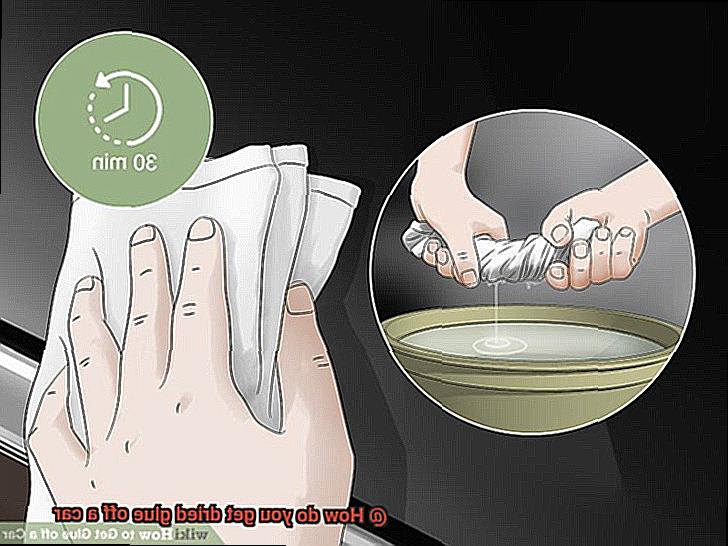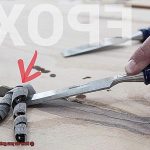Have you ever noticed stubborn bits of glue clinging to your car windows and doors? It’s a frustrating sight that can ruin the overall appearance of your vehicle. But don’t worry, you’re not alone. Adhesive residues are one of the most challenging things to remove from your car. They can come from a variety of sources like peeling off stickers or excess smearing from tinting your car windows.
Dried glue on a car is not only an eyesore, but it also attracts dust and debris, making it even more unsightly. That’s why we’ve put together this blog post to help you remove dried glue effectively from your car. We’ll guide you through different methods and products used in the process of eliminating every trace of stubborn adhesive from your beloved car. Plus, we’ll highlight sure-fire steps to safeguard your car’s paint and material while taking off those pesky glue streaks.
Whether you’re a seasoned car enthusiast or just an average driver, we’ve got you covered with our step-by-step guide on how to unstick that unwanted, dried glue from your car in an efficient and cost-effective way. So let’s get started.
What is Dried Glue?
Contents
- 1 What is Dried Glue?
- 2 Steps to Remove Dried Glue from a Car
- 3 Softening the Glue with Heat
- 4 Scraping off the Glue
- 5 Removing Residual Glue with Solvents
- 6 Choosing a Safe Solvent for Your Car’s Paint
- 7 Applying the Solvent on the Residual Glue
- 8 Washing off Any Remaining Residue
- 9 Tips for Removing Dried Glue from a Car
- 10 Conclusion
Dried glue is a problem that many people encounter while working on projects or accidentally spilling glue onto their car. It’s a frustrating and unsightly issue that can cause stress for many vehicle owners. In this article, we will delve into what dried glue is, the different types of glue available, and how to safely remove it from your car’s surface.
What exactly is dried glue?
Dried glue refers to the solidified form of liquid adhesive. There are various types of glue available, each with its unique properties and uses. One of the most common types of glue is polyvinyl acetate (PVA) glue, which is a white liquid adhesive that dries clear. Another type of glue is cyanoacrylate, also known as superglue, which is a fast-drying adhesive that forms a strong bond.
Why does dried glue occur?
In its liquid form, glue is a common adhesive used to bond various surfaces together. However, when the glue dries, it solidifies and can become difficult to remove from surfaces such as a car’s exterior. Dried glue can also leave behind unsightly residue that can be challenging to clean.
Different types of glue:
As mentioned earlier, there are various types of glue available for different purposes. Some common types include PVA glue, superglue, epoxy adhesive, contact cement, and hot melt adhesive.
How to safely remove dried glue from your car’s surface:
If you find dried glue on your car’s exterior, there is no need to panic. There are simple steps you can follow to remove it without causing any damage to your car’s paint.
Step 1: Soften the Glue
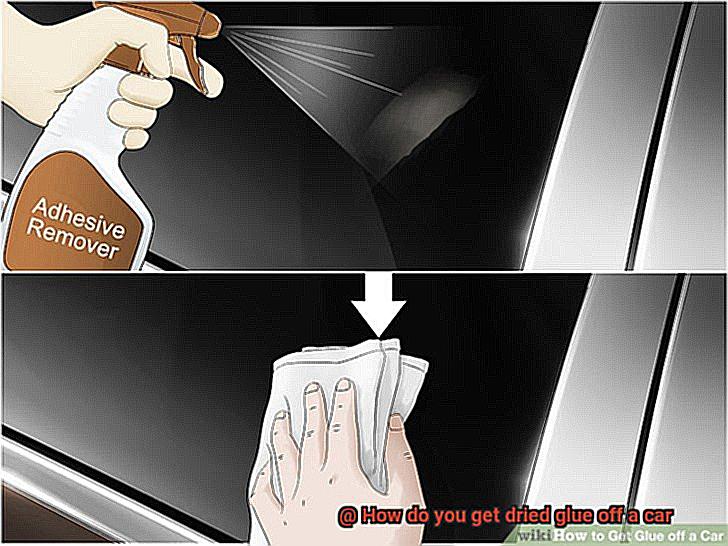
Use a hairdryer or heat gun to soften the glue. The heat will break down the bond between the glue and the car’s surface and make it easier to remove.
Step 2: Scrape off the Glue
Once the glue has softened, gently scrape it off with a plastic scraper or a credit card. Always check your progress, and be careful not to scratch the car’s paint. It’s important to use a plastic scraper instead of a metal one to avoid damaging the paint.
Step 3: Use a Solvent
Steps to Remove Dried Glue from a Car
Whether it was a mishap during a DIY project or a reckless accident, removing the glue can be a daunting task. But fear not, with the right tools and techniques, you can restore your car’s surface to its former glory. Here are the steps to remove dried glue from a car:
Step 1: Scrape Away Excess Glue
First things first, take a plastic scraper or credit card and gently scrape off any excess glue from your car’s surface, being careful not to scratch the paintwork. The more glue you can remove at this stage, the easier it will be to proceed.
Step 2: Soak the Glue with Warm Water
Next, soak a clean cloth in warm water and place it over the affected area. Give it a few minutes to work its magic and soften the glue.
Step 3: Apply an Adhesive Remover
It’s time to bring in some heavy artillery. Apply an adhesive remover like Goo Gone or WD-40 to the affected area. Follow the instructions on the label and avoid using too much product.
Step 4: Let the Remover Sit
Be patient and give the remover time to dissolve the adhesive. Let it sit for a few minutes before moving on to the next step.
Step 5: Scrub the Area
Use a soft-bristled brush or toothbrush to gently scrub the affected area in circular motions. This will help remove any remaining glue.
Step 6: Rinse and Dry
Rinse the area with clean water and dry it with a soft towel.
Step 7: Polish and Wax
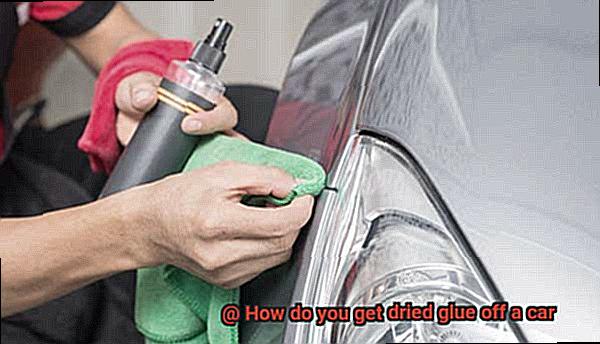
Celebrate your victory over the stubborn glue by restoring your car’s paint finish. Use a polishing compound and wax to give your car a shiny new look.
It’s worth noting that different types of glue may require different removal methods. To avoid damaging your car’s surface, always consult your car manufacturer or a professional auto detailer for advice.
Softening the Glue with Heat
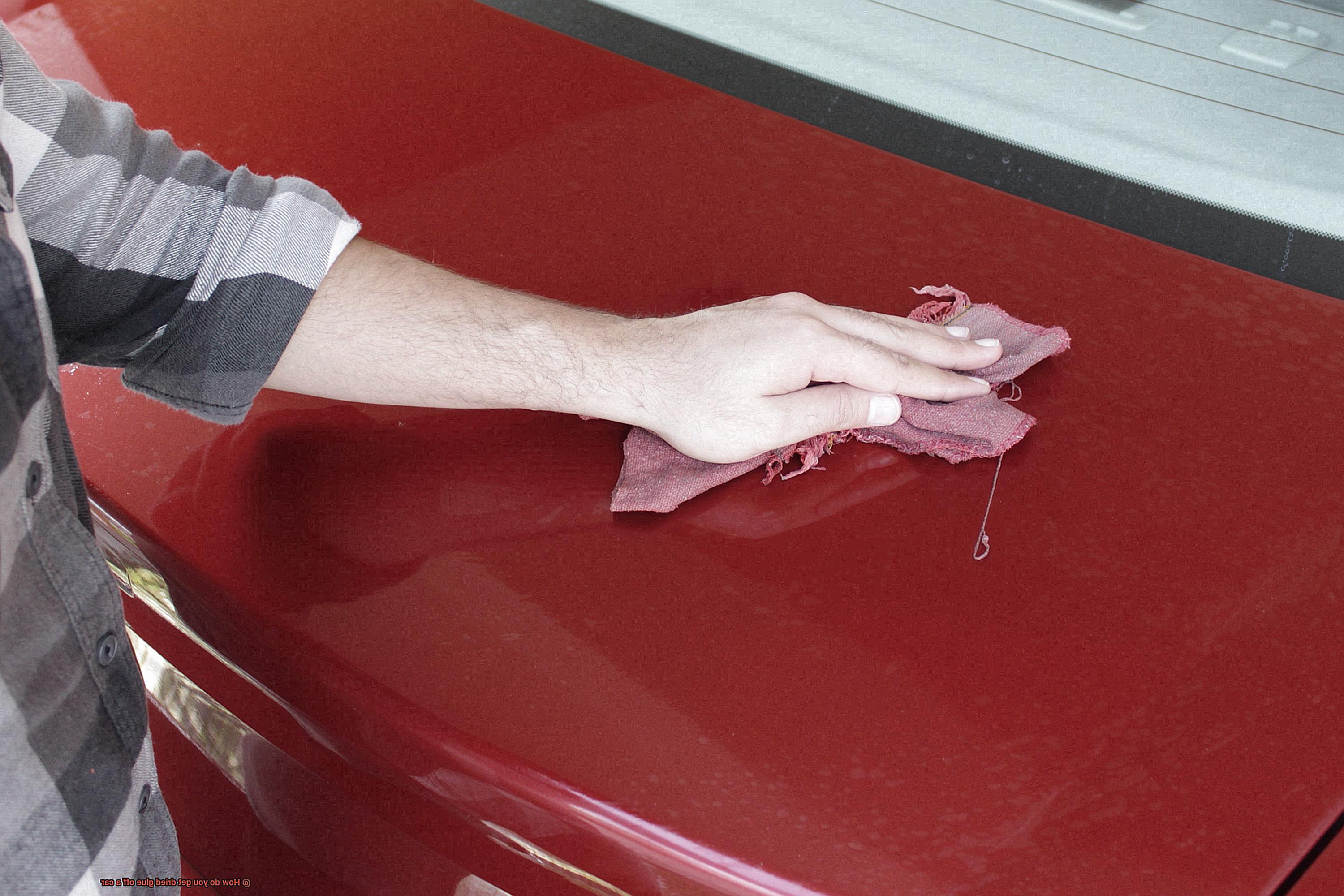
Removing dried glue from your car can be a frustrating and time-consuming task. However, there is a simple solution to make this process much easier – softening the glue with heat. As an expert in this field, I have compiled some simple steps and safety precautions to help you effectively remove dried glue from your car.
Firstly, it is important to ensure that the area around the glue is clean and free of any debris. This will prevent any scratches or damage to your car’s surface during the removal process. Additionally, it is crucial to wear protective gloves and eyewear when using a heat gun or boiling water.
Now, let’s explore the various ways you can apply heat to the glue. You can use a heat gun, a hairdryer, or even boiling water.
Using a heat gun involves pointing it directly at the dried glue and moving it back and forth until the glue begins to soften and melt. Once the glue becomes pliable, gently remove it from your car’s surface using a plastic scraper or credit card. Remember not to apply too much pressure as this can cause scratches or other damage.
Alternatively, you can use a hairdryer set to its highest temperature setting. By directing the hot air onto the dried glue, you can soften it without applying too much heat. Once softened, use a plastic scraper or credit card to remove the glue from your car’s surface.
Boiling water is another option. Simply pour boiling water over the affected area and let it sit for several minutes until the glue has softened. Then, use a plastic scraper or credit card to gently remove the glue from your car’s surface.
It is important to note that while softening glue with heat can be an effective method for removing dried glue from your car, it may not work for all types of glue. Moreover, excessive heat can damage some car surfaces like paint or plastic. Therefore, always test a small, inconspicuous area before attempting to remove dried glue from a larger area of the car.
Scraping off the Glue
But fear not. With the right tools and techniques, you can easily scrape off the glue and restore your car’s pristine appearance.
To start, ensure that the area around the glue is clean and dry. Use a clean cloth or towel to wipe away any dirt or debris that may be present. This will give you a clear view of the glue and prevent accidental scratches on your car’s surface.
Then, grab a plastic scraper or a razor blade and begin gently scraping away the glue from your car’s surface. Remember to apply gentle pressure and avoid using too much force, as this could cause damage to your car’s paint job. If using a razor blade, make sure it’s sharp and held at a slight angle to avoid scratching or damaging the paint.
If the glue proves difficult to remove, try applying a lubricant such as WD-40 or rubbing alcohol to loosen it up. Allow the lubricant to sit for a few minutes before attempting to scrape it away.
It is crucial to work slowly and carefully while scraping off the glue to avoid causing any damage. Take your time and be patient; multiple passes with the scraper or razor blade may be necessary to remove all of the glue.
Once you’ve removed as much of the glue as possible, use a clean cloth or towel to wipe away any residue left behind. And just like that, your car’s surface should be free of dried glue.
Removing Residual Glue with Solvents
If you’ve ever tried to remove a sticker or decal from your car, you know how frustrating it can be to deal with the sticky residue that’s often left behind. But fear not, my fellow car enthusiasts. As an expert in removing residual glue with solvents, I’m here to share some tips on how to safely and effectively get rid of that pesky residue.
First things first – it’s important to choose the right solvent for the job. Not all solvents are created equal, and some can actually cause damage to your car’s paint or finish. So what should you use? Rubbing alcohol or isopropyl alcohol are both safe options that can effectively dissolve glue residue. Simply apply the alcohol to a clean cloth and rub it onto the affected area. Then, rinse with water and dry thoroughly.
If you prefer a commercial adhesive remover specifically designed for cars, there are many options available at auto supply stores or online. These products are typically safe for use on car surfaces and can effectively remove residual glue. Just be sure to follow the instructions carefully and rinse and dry the area afterwards.
Now, let’s talk about what not to do. Avoid using harsh solvents such as acetone or gasoline, as these can cause serious damage to your car’s paint or finish. And don’t even think about using abrasive tools like scouring pads or steel wool – they can leave unsightly scratches on your vehicle’s surface.
Choosing a Safe Solvent for Your Car’s Paint
You don’t have to worry about damaging your car’s finish when removing it. As an expert, I can provide you with valuable information on choosing a safe solvent for your car’s paint.
The first option is rubbing alcohol, which is one of the safest solvents available for removing dried glue from your car. You can easily purchase it from grocery stores or hardware shops. Simply apply a soft cloth or sponge soaked in rubbing alcohol and gently rub the affected area until the glue comes off. However, be careful not to scrub too hard as it may damage the paint.
Another affordable and safe option is vinegar. This effective solvent can be mixed with warm water at equal parts and applied to the affected area using a soft cloth or sponge. Leave the solution for a few minutes before gently rubbing the area until the glue comes off.
If you don’t have rubbing alcohol or vinegar, don’t panic. A mild dish soap solution can also get rid of dried glue residue. Mix a few drops of dish soap with warm water and apply it to the affected area using a soft cloth or sponge. Wait for a few minutes before gently rubbing the area until the glue comes off.
It is worth noting that you need to test any solvent first on a small and inconspicuous area before applying it to the entire affected area. Choosing a safe solvent is crucial when removing dried glue from your car’s surface. With these safe and effective options, you’ll have your car looking as good as new in no time.
To summarize, here are some key takeaways:
Applying the Solvent on the Residual Glue
But don’t worry, I am here to share my expert knowledge on the best way to tackle this issue.
The first step is crucial – choose the right solvent for the job. Rubbing alcohol, mineral spirits, and acetone are all effective solvents that can dissolve glue. However, it’s essential to test the solvent on an inconspicuous area of your car’s surface before applying it to the entire area. You don’t want to damage your car’s paint or finish in the process.
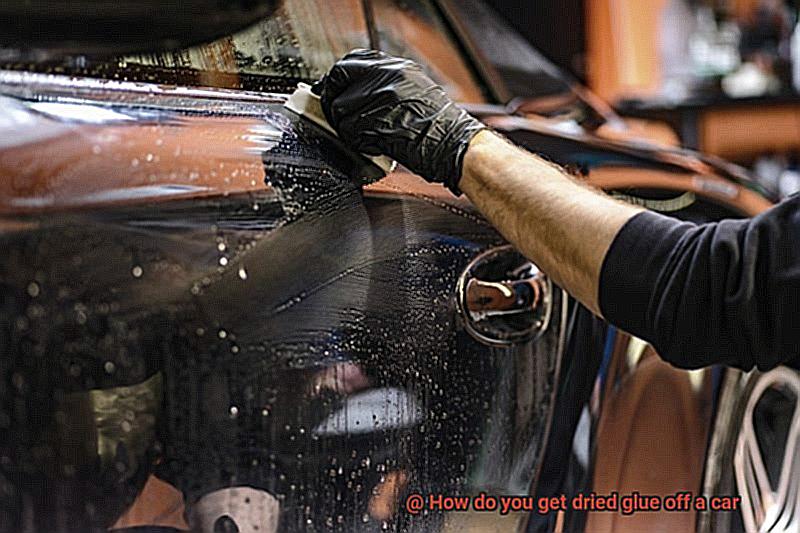
Once you’ve found a safe solvent, apply it directly onto the residual glue using a clean cloth or rag. Avoid using abrasive materials that could scratch your car’s surface. Let the solvent sit on the glue for a few minutes to soften it up and make it easier to remove.
To remove the glue, gently scrape it off using a plastic scraper or credit card. Applying too much pressure could cause damage, so be cautious and gentle. If there is still glue residue left over, repeat the process until all traces of glue are removed.
Lastly, clean the area with soap and water and dry it with a clean cloth. Your car’s surface will look as good as new.
Here are some important tips to keep in mind:
- Choose the right solvent: rubbing alcohol, mineral spirits, and acetone are all effective solvents.
- Test the solvent on an inconspicuous area first.
- Apply the solvent with a clean cloth or rag.
- Avoid using abrasive materials that could scratch your car’s surface.
- Let the solvent sit for a few minutes before scraping off the glue.
- Be gentle when scraping off the glue to avoid causing damage.
- Repeat the process if there is still glue residue left over.
- Clean the area with soap and water and dry it with a clean cloth.
Washing off Any Remaining Residue
If you’ve been struggling with removing dried glue from your car, don’t worry. After scraping off as much of the stubborn adhesive residue as possible, the next step is to wash off any remaining residue with care. In this post, I’ll be sharing my expert tips on how to do this safely and effectively.
To start, it’s crucial to choose a gentle yet effective detergent that won’t damage your car’s paint or finish. A mild soap solution or specialized car wash solution is highly recommended. These detergents are specifically designed to remove leftover residue without causing any damage.
Begin by wetting the affected area with water and gently applying the soap solution using a soft cloth or sponge. It’s important to be gentle and avoid applying too much pressure or scrubbing too hard. This can easily cause scratches or damage to the car’s surface.
After thoroughly washing off the residue with soap and water, rinse it off with water and inspect the area. If there is still some glue residue left, repeat the washing process until it’s completely removed. Patience is key here – it may take a few attempts to completely remove all traces of residue.
For particularly stubborn residue that refuses to budge, a stronger adhesive remover may be necessary. However, it’s important to exercise caution when using these products as they can be harsh and potentially damage your car’s surface. Always follow instructions carefully and test on a small, inconspicuous area first before applying it to the entire affected area.
Once all the glue residue is removed, rinse off any remaining detergent with water and dry your car using a soft towel or chamois. Avoid air drying as this can leave unsightly water spots on your car’s surface.
Tips for Removing Dried Glue from a Car
Removing Dried Glue from Your Car – Tips and Techniques
Accidentally spilling glue on your car can be a nightmare, especially when it dries and hardens. However, removing dried glue from your car is not an impossible task. It requires some patience and the right tools and techniques. Here are some tips on how to safely remove dried glue from your car without causing damage.
Identify the Type of Glue
The first step in removing dried glue from your car is to identify the type of glue that was used. This will help you choose the right removal method. If the glue is water-based, warm water and soap may be enough to dissolve it. However, if the glue is a stronger adhesive like epoxy or superglue, a solvent-based remover may be necessary.
Softening the Glue
Once you have identified the type of glue, the next step is to soften it. Heat can help soften the glue, so use a heat gun or hairdryer to direct heat at the glue for a few minutes until it begins to soften and melt. Be careful not to overheat as this can damage the paint.
Scraping the Glue
After softening the glue, use a plastic scraper or credit card to gently scrape away as much of the glue as possible. Be patient and gentle while doing this, so you don’t scratch the surface of your car. Keep checking your progress and stop scraping if you notice any damage.
Using Solvent
If there is still some residue left after scraping, you can use a solvent to remove it. Rubbing alcohol or acetone are good options but make sure to test them on a small area first. Apply the solvent on a cloth and rub it on the remaining glue until it comes off completely. Don’t apply too much pressure as it can damage your car’s paint.
Using Commercial Adhesive Remover
If the glued area is too stubborn, you may need to try a commercial adhesive remover. These products are specifically designed for cars and are available at most auto parts stores. Be sure to choose a product that is safe for use on automotive paint and follow the instructions carefully.
Washing the Area
After removing the glue, wash the area with soap and water to remove any leftover residue. This will help ensure that no residue is left behind that could damage your car’s paint over time. Dry the area with a clean cloth.
Ssc3lb-5Uzs” >
Conclusion
In conclusion, removing dried glue from a car can seem like a daunting task, but with the right tools and techniques, it can be done effectively.
Remember to always start with the gentlest method first and work your way up if necessary. Whether you choose to use household items like vinegar or opt for specialized products, take your time and be patient.
With some elbow grease and persistence, your car will be back to its shiny and spotless state in no time.

